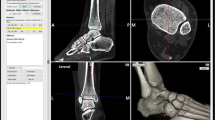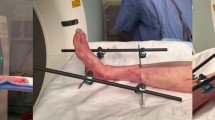Abstract
Purpose
To define a new parameter in CT that could make imaging of the contralateral ankle dispensable evaluating the position of the fibula after syndesmotic injury.
Methods
Thirty bilateral CTs of 30 patients were included. Five parameters were defined in axial CT for the injured (_inju) and uninjured (_unin) ankle. Reproducibility was examined for inter-observer and intra-observer reliability. Comparisons for all parameters were performed between the CT scans of both ankles.
Results
All measurements had a high agreement for the inter-observer and intra-observer correlation coefficients. A large interindividual variance could be found between all parameters. If the difference of the anterior tibiofibular distance antTFD_unin and antTFD_inju was less than 2 mm, there was a strong significant pairwise correlation between all parameters between both sides.
Conclusion
Bilateral CT is still to be recommended, as it is the only way to exactly assess anterior posterior reduction of the fibula.



Similar content being viewed by others
References
Tornetta P, Axelrad TW, Sibai TA, Creevy WR (2012) Treatment of the stress positive ligamentous SE4 ankle fracture: incidence of syndesmotic injury and clinical decision making. J Orthop Trauma 26:659–661. https://doi.org/10.1097/BOT.0b013e31825cf39c
Jensen SL, Andresen BK, Mencke S, Nielsen PT (1998) Epidemiology of ankle fractures. A prospective population-based study of 212 cases in Aalborg, Denmark. Acta Orthop Scand 69:48–50
Rammelt S, Zwipp H, Grass R (2008) Injuries to the distal tibiofibular syndesmosis: an evidence-based approach to acute and chronic lesions. Foot Ankle Clin 13:611–633, vii–viii. https://doi.org/10.1016/j.fcl.2008.08.001
Sagi HC, Shah AR, Sanders RW (2012) The functional consequence of syndesmotic joint malreduction at a minimum 2-year follow-up. J Orthop Trauma 26:439–443. https://doi.org/10.1097/BOT.0b013e31822a526a
Vasarhelyi A, Lubitz J, Gierer P et al (2006) Detection of fibular torsional deformities after surgery for ankle fractures with a novel CT method. Foot Ankle Int 27:1115–1121. https://doi.org/10.1177/107110070602701219
Weening B, Bhandari M (2005) Predictors of functional outcome following transsyndesmotic screw fixation of ankle fractures. J Orthop Trauma 19:102–108
Gardner MJ, Demetrakopoulos D, Briggs SM et al (2006) Malreduction of the tibiofibular syndesmosis in ankle fractures. Foot Ankle Int 27:788–792. https://doi.org/10.1177/107110070602701005
Marmor M, Hansen E, Han HK et al (2011) Limitations of standard fluoroscopy in detecting rotational malreduction of the syndesmosis in an ankle fracture model. Foot Ankle Int 32:616–622. https://doi.org/10.3113/FAI.2011.0616
Miller AN, Carroll EA, Parker RJ et al (2009) Direct visualization for syndesmotic stabilization of ankle fractures. Foot Ankle Int 30:419–426. https://doi.org/10.3113/FAI.2009.0419
Rammelt S, Obruba P (2015) An update on the evaluation and treatment of syndesmotic injuries. Eur J Trauma Emerg Surg 41:601–614. https://doi.org/10.1007/s00068-014-0466-8
Franke J, von Recum J, Suda AJ et al (2012) Intraoperative three-dimensional imaging in the treatment of acute unstable syndesmotic injuries. J Bone Joint Surg Am 94:1386–1390. https://doi.org/10.2106/JBJS.K.01122
Franke J, von Recum J, Suda AJ et al (2014) Predictors of a persistent dislocation after reduction of syndesmotic injuries detected with intraoperative three-dimensional imaging. Foot Ankle Int 35:1323–1328. https://doi.org/10.1177/1071100714549047
Davidovitch RI, Weil Y, Karia R et al (2013) Intraoperative syndesmotic reduction: three-dimensional versus standard fluoroscopic imaging. J Bone Joint Surg Am 95:1838–1843. https://doi.org/10.2106/JBJS.L.00382
Summers HD, Sinclair MK, Stover MD (2013) A reliable method for intraoperative evaluation of syndesmotic reduction. J Orthop Trauma 27:196–200. https://doi.org/10.1097/BOT.0b013e3182694766
Dikos GD, Heisler J, Choplin RH, Weber TG (2012) Normal tibiofibular relationships at the syndesmosis on axial CT imaging. J Orthop Trauma 26:433–438. https://doi.org/10.1097/BOT.0b013e3182535f30
Cotton F (1910) Fractures and joint dislocations. WB Saunders, Philadelphia
Stoffel K, Wysocki D, Baddour E et al (2009) Comparison of two intraoperative assessment methods for injuries to the ankle syndesmosis. A cadaveric study. J Bone Joint Surg Am 91:2646–2652. https://doi.org/10.2106/JBJS.G.01537
Beumer A, Swierstra BA (2003) The influence of ankle positioning on the radiography of the distal tibial tubercles. Surg Radiol Anat 25:446–450. https://doi.org/10.1007/s00276-003-0147-5
Landis JR, Koch GG (1977) The measurement of observer agreement for categorical data. Biometrics 33:159–174
Phisitkul P, Ebinger T, Goetz J et al (2012) Forceps reduction of the syndesmosis in rotational ankle fractures: a cadaveric study. J Bone Joint Surg Am 94:2256–2261. https://doi.org/10.2106/JBJS.K.01726
Kocadal O, Yucel M, Pepe M et al (2016) Evaluation of reduction accuracy of suture-button and screw fixation techniques for syndesmotic injuries. Foot Ankle Int 37:1317–1325. https://doi.org/10.1177/1071100716661221
Thordarson DB, Motamed S, Hedman T et al (1997) The effect of fibular malreduction on contact pressures in an ankle fracture malunion model. J Bone Joint Surg Am 79:1809–1815
Mukhopadhyay S, Metcalfe A, Guha AR et al (2011) Malreduction of syndesmosis--are we considering the anatomical variation? Injury 42:1073–1076. https://doi.org/10.1016/j.injury.2011.03.019
Boszczyk A, Kwapisz S, Krümmel M et al (2018) Correlation of Incisura anatomy with syndesmotic malreduction. Foot Ankle Int 39:369–375. https://doi.org/10.1177/1071100717744332
Bartoníček J, Rammelt S, Tuček M (2017) Posterior malleolar fractures: changing concepts and recent developments. Foot Ankle Clin 22:125–145. https://doi.org/10.1016/j.fcl.2016.09.009
Availability of data and material
The datasets used and/or analyzed during the current study are available from the corresponding author on reasonable request.
Code availability
Not applicable
Author information
Authors and Affiliations
Contributions
All authors contributed to the study conception and design. Data collection and analysis were performed by Annette B. Ahrberg and Ulrich J. Spiegl. The first draft of the manuscript was written by Annette B. Ahrberg, and all authors commented on previous versions of the manuscript. All authors read and approved the final manuscript.
Corresponding author
Ethics declarations
Conflict of interest
The authors declare that they have no conflict of interest.
Ethics approval
Approval of the local institutional review board for study had been given (Ethical Committee at the Medical Faculty, Leipzig University, AZ 131/18-ek) in view of the retrospective nature of the study, and all the procedures being performed were part of the routine care.
Consent to participate
All individuals have given general consent in the use of their data, including imaging, for analysis and publication. This has been approved by the Ethical Committee.
Consent for publication
All individuals have given general consent in the use of their data, including imaging, for analysis and publication. This has been approved by the Ethical Committee.
Additional information
Publisher’s note
Springer Nature remains neutral with regard to jurisdictional claims in published maps and institutional affiliations.
Rights and permissions
About this article
Cite this article
Ahrberg, A.B., Hennings, R., von Dercks, N. et al. Validation of a new method for evaluation of syndesmotic injuries of the ankle. International Orthopaedics (SICOT) 44, 2095–2100 (2020). https://doi.org/10.1007/s00264-020-04631-9
Received:
Accepted:
Published:
Issue Date:
DOI: https://doi.org/10.1007/s00264-020-04631-9




